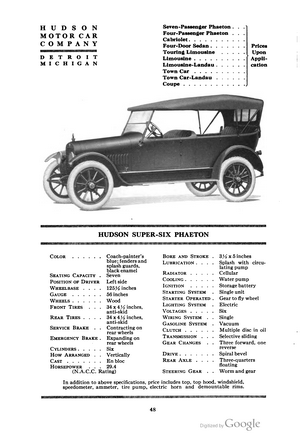















Hudson |
|---|
|
| External Links |
|---|
| Wikipedia: Hudson Motor Car Company |
| Page Sections |
|
History
Images Motorsports Documents Article Index |
History
The following section is an excerpt from Wikipedia's Hudson Motor Car Company page on 12 December 2015, text available via the Creative Commons Attribution-ShareAlike 3.0 Unported License.
The Hudson Motor Car Company made Hudson and other brand automobiles in Detroit, Michigan, from 1909 to 1954. In 1954, Hudson merged with Nash-Kelvinator Corporation to form American Motors (AMC). The Hudson name was continued through the 1957 model year, after which it was discontinued.
The name "Hudson" came from Joseph L. Hudson, a Detroit department store entrepreneur and founder of Hudson's department store, who provided the necessary capital and gave permission for the company to be named after him. A total of eight Detroit businessmen formed the company on February 20, 1909, to produce an automobile which would sell for less than US$1,000 (equivalent to approximately $26,337 in today's funds). One of the chief "car men" and organizer of the company was Roy D. Chapin, Sr., a young executive who had worked with Ransom E. Olds. (Chapin's son, Roy Jr., would later be president of Hudson-Nash descendant American Motors Corp. in the 1960s). The company quickly started production, with the first car driven out of a small factory in Detroit on July 3, 1909.
The new Hudson "Twenty" was one of the first low-priced cars on the American market and very successful with more than 4,000 sold the first year. The 4,508 units made in 1910 was the best first year's production in the history of the automobile industry and put the newly formed company in 17th place industry-wide, "a remarkable achievement at a time" because there were hundreds of makes being marketed. Because of this sales success a new plant was built on a 22-acre parcel at Jefferson Avenue and Conner Avenue in Detroit's Fairview section that was diagonally across from the Chalmers Automobile plant. The land was the former farm of D. J. Campau. It was designed by the firm of renowned industrial architect Albert Kahn with 223,500 square feet and opened on October 29, 1910. Production in 1911 increased to 6,486. For 1914 Hudsons for the American market were now left hand drive.
The company had a number of firsts for the auto industry; these included dual brakes, the use of dashboard oil-pressure and generator warning lights, and the first balanced crankshaft, which allowed the Hudson straight-six engine, dubbed the "Super Six" (1916), to work at a higher rotational speed while remaining smooth, developing more power for its size than lower-speed engines. The Super Six was the first engine built by Hudson, previously Hudson had developed engine designs and then had them manufactured by Continental Motors Company. Most Hudsons until 1957 had straight-6 engines. The dual brake system used a secondary mechanical emergency brake system, which activated the rear brakes when the pedal traveled beyond the normal reach of the primary system; a mechanical parking brake was also used. Hudson transmissions also used an oil bath and cork clutch mechanism that proved to be as durable as it was smooth.
On 1 July 1926, Hudson's new 10 million dollar body plant was completed where the automaker could now build the all-steel closed bodies for both the Hudson and Essex models.
At their peak in 1929, Hudson and Essex produced a combined 300,000 cars in one year, including contributions from Hudson's other factories in Belgium and England; a factory had been built in 1925 in Brentford in London. Hudson was the third largest U.S. car maker that year, after Ford Motor Company and Chevrolet.
 |
Subject: Hudson Super-Six Phaeton
Source: Hand Book of Automobiles, 1919 Edition View Hudson Super-Six Phaeton page of Hand Book of Automobiles, 1919 Edition - 620KB |
In the third year of competition, Hudson was the second marque of a championship driver in NASCAR's top-level series, the series that would eventually become Sprint Cup (Oldsmobile was the winner's car the first two seasons). The Hudson Hornet dominated three years of NASCAR Grand National racing, a series of accomplishments that was depicted by the Doc Hudson character in the animated movie Cars.
Championships Won in Hudsons
| Year | Series | Driver | Model |
|---|---|---|---|
| 1951 | NASCAR Grand National | Herb Thomas | Hornet |
| 1952 | NASCAR Grand National | Tim Flock | Hornet |
| 1953 | NASCAR Grand National | Herb Thomas | Hornet |
| Date | Document Name & Details | Documents |
|---|---|---|
| Compilation: October 1911-June 1913 | The Hudson Triangle | PDF - 102MB - 370 pages |
| 1916 | Letters from a Successful Hudson Dealer to His Son Hudson Motor Car Company | Topic Page - 99 pages |
| 1948 | Hudson Operating Instructions Hudson | Topic Page - 4 pages |
| Date | Article | Author/Source |
|---|---|---|
| 12 December 1922 | HUDSON CUTS CAR PRICES. | The New York Times |
| 28 December 1922 | HUDSON MOTOR CO. PROFITS | The New York Times |
| 21 September 1924 | FIRST SEDAN BUILT BY HUDSON MOTOR COMPANY IN 1913 | The Pittsburgh Press |
| 3 November 1925 | AMAZING GROWTH OF HUDSON MOTOR | The New York Times |
| 25 December 1925 | HUDSON MOTOR'S BIG YEAR | The New York Times |
| 23 September 1947 | Hudson Motor Making Unique Automobile | The Independent |
